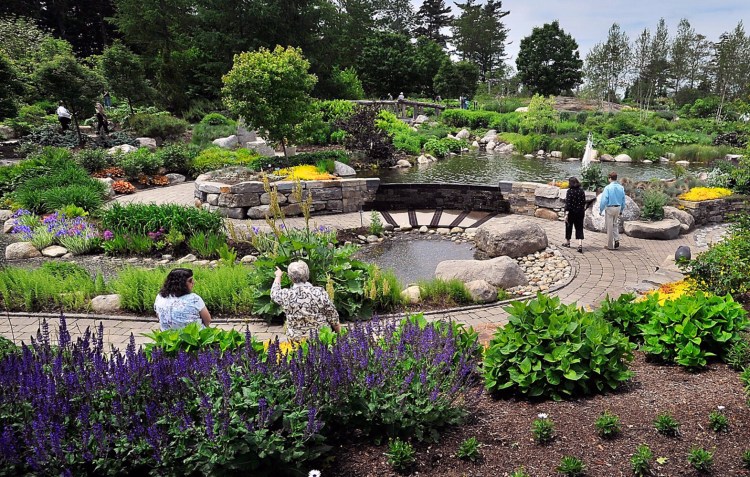When casual gardeners want a new plant for their garden, usually they just go to the local nursery and buy one. But you can propagate new plants yourself, too, and there are good reasons to do so. Coastal Maine Botanical Gardens is propagating more of its own plants than it ever has before, according to Andrew Brand, director of horticulture for the Boothbay garden.
Propagating plants saves the gardens money, Brand told members of the Garden Club Federation of Maine during a May visit, as the staff does the work itself, and it gives the garden more control over its new plants, too. Moreover, self-propagation is friendlier to the environment.
The grand hope of self-propagation at the botanical gardens is that one day the garden crew can create a cultivar that is unique and popular and makes the garden some money. If it’s a highly popular cultivar, it could mean a lot of money. But that will take both skill and luck.
The talk on propagation – Dan Robarts, chief grower at the gardens, also spoke – was part of a daylong visit to the gardens by the state garden club. (I am a member of both organizations.)
Plants can be propagated several ways. In sexual propagation, pollen is transferred from one blossom to another, fertilizing the plant and creating a seed. In the real world, bees, moths and other insects or animals go from flower to flower to do this work.
Sometimes, those other animals are humans. “I get to play bumblebee,” Robarts said, describing how he transfers pollen from male plants to female plants in a greenhouse; it involves neither buzzing nor flying, but the simple transfer of pollen. The pollination produces seeds, which the staff then plants to create a new plant.
Sexual reproduction of plants is fast and relatively inexpensive. The problem is that while the new offspring plants have many similar traits to their parents, they are not identical to them. It’s the same with human siblings – people share traits with their brothers and sisters and parents, but there are differences, too.
In the wild, and often in the garden, those differences are a good thing. Say a disease develops for the species. Some individual plants in the species might be more resistant to it and able to survive the disease. Also, the insects that developed along with the plants over thousands of years are more accustomed to the species than to the human-created cultivars.
But big plant breeders believe that people buying plants want all plants with the same name to look exactly the same. If someone buys, for example, a ‘Capistrano’ Rhododendron – which were in absolute gorgeous bloom when we visited the botanical gardens – they are looking for a dense evergreen rhododendron with lots of large yellow flowers. These identical plants are cultivars and are not created by sexual reproduction.
When the staff at the botanical gardens is creating plants by seed, they keep an eye out for any unusual traits. If they find one – Brand and Robarts showed garden club members an aster with a white stripe running down the stem as an example – they may display that plant in the garden. Also, when an interesting specimen is found, the staff propagates it by tissue culture. They conduct that process in a sterile environment, putting a part of the leaf, stem or root in a solution. If all goes well, it will produce a new plant that is identical to the original.

One way to propagate plants is to take a cutting and root it in water or a rooting solution. MilicaKnez/Shutterstock
Home gardeners – including my wife, Nancy – sometimes do this (though more casually, and lacking a sterile environment) when, for example, they bring pussy willow stems inside and put them in water. When the plants develop roots, they can then be transplanted into the soil.
The simplest way to self-propagate is plant division. Say a plant – at our house, it’s usually a hosta or daylily – is outgrowing its allotted garden space. We dig up the plant, divide it and return just part of it to its original spot. The remainder is moved elsewhere in the garden, or we give it away.
Are you wondering why propagation on-site is better for the environment than simply buying new plants? First, no gas is used or polluting emissions generated to move the seedling from a propagating greenhouse to a nursery to your own garden. Also – and I’m surprised I didn’t already know this – the black plastic used in horticulture cannot be recycled. It’s simply trash. Garden staff that does its own plant propagation can reduce the amount of trash it generates by reusing plastic seedling trays and pots for as long as they remain sturdy, and only then throwing them away.
Tom Atwell is a freelance writer gardening in Cape Elizabeth. He can be contacted at: tomatwell@me.com.
Send questions/comments to the editors.



Success. Please wait for the page to reload. If the page does not reload within 5 seconds, please refresh the page.
Enter your email and password to access comments.
Hi, to comment on stories you must . This profile is in addition to your subscription and website login.
Already have a commenting profile? .
Invalid username/password.
Please check your email to confirm and complete your registration.
Only subscribers are eligible to post comments. Please subscribe or login first for digital access. Here’s why.
Use the form below to reset your password. When you've submitted your account email, we will send an email with a reset code.